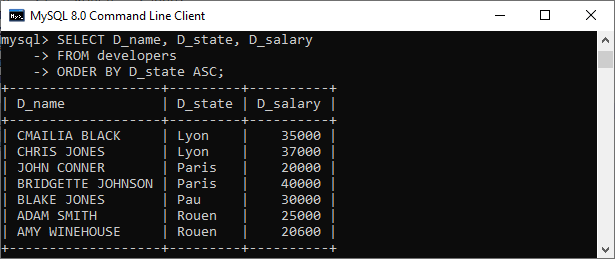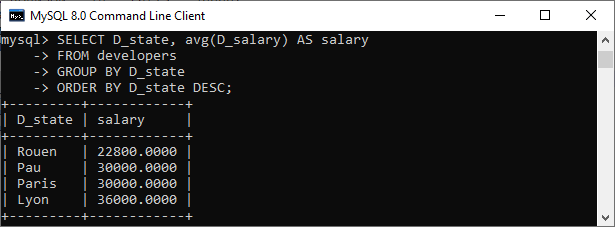SQL Tutorial
SQL Database
SQL Table
SQL Select
SQL Order By
SQL Insert
SQL Update
SQL Delete
Difference
SQL Injection
SQL String Functions
Miscl
- SQL Formatter
- SQL group by
- SQL add/drop/update column operation
- SQL CAST Function
- SQL Comments
- SQL CONCAT Function
- CTE (Common Table Expression)SQL
- How to use distinct in SQL?
- Joining Three or More Tables in SQL
- What is Web SQL?
- How to create functions in SQL?
- How to run SQL Script?
- How to Delete Duplicate Rows in SQL?
- Nth Highest salary
- 12 Codd's Rules
- SQL EXCEPT
- Types of SQL JOIN
- Change datatype of column in SQL
- SQL Auto Increment
- SQL Like
- Commit and Rollback in SQL
- SQL Concatenate
- SQL get month from the date
- Savepoint in SQL
- SQL ORDER BY DATE
- TIME Datatype in SQL
- SQL BETWEEN
- CRUD Operations in SQL
- SQL INDEX
- Scalar Functions in SQL
- SET Operators in SQL
- Types of SQL Commands
- TCL Commands in SQL
- SQL Subquery
- SQL View
- Constraints in SQL
- Pattern Matching in SQL
- SQL Date Functions
- DDL Commands in SQL
- DML Commands in SQL
- SQL CASE
- SQL Inner Join
- SQL IN Operator
- Check Constraint in SQL
- SQL CLAUSES
- SQL LOGICAL OPERATORS
- Delete Column from Table
- Add Column in the Table
- Delete one row in SQL
- Change the Column Value
- How to Add Foreign Key in SQL
- Add a Primary Key
- Insert One or More rows
- How to Use LIKE in SQL
- Cursor in SQL
- Difference Between DROP and Truncate
- SQL Comparison Operators
- SQL COUNT WHERE
- SQL SELECT MIN
- SQL Stored Procedure
- SQL SELECT AVG
- SQL SELECT MAX
- SQL ADD COLUMN
- How to use Auto-Increment in SQL
- SQL Languages
- SQL Arithmetic Operators
- How to Use GROUP BY in SQL
- How to Use ORDER BY in SQL
- Trigger in SQL
- What is Race Condition
- SQL COUNT DISTINCT
PL/SQL Tutorial
Sql Interview Question
SQl Quiz
GROUP BY vs. ORDER BY
This article explains the complete overview of the GROUP BY and ORDER BY clause. They are mainly used for organizing data obtained by SQL queries. The difference between these clauses is one of the most common places to get stuck when learning SQL. The main difference between them is that the GROUP BY clause is applicable when we want to use aggregate functions to more than one set of rows. The ORDER BY clause is applicable when we want to get the data obtained by a query in the sorting order. Before making the comparison, we will first know these SQL clauses.

ORDER BY Clause
The ORDER BY clause is used in SQL queries to sort the data returned by a query in ascending or descending order. If we omit the sorting order, it sorts the summarized result in the ascending order by default. The ORDER BY clause, like the GROUP BY clause, could be used in conjunction with the SELECT statement. ASC denotes ascending order, while DESC denotes descending order.
The following is the syntax to use the ORDER BY clause in a SQL statement:
FROM tables
[WHERE conditions]
ORDER BY expression [ ASC | DESC ];
Let us understand how the ORDER BY clause works with the help of the following example. Suppose we have a table developer that contains the following data:

We can see that these results are not displayed in an organized way. Suppose we want to organize results in ascending or descending order based on the state column. In that case, we would need the ORDER BY command to get the desired result. We can do this by executing the command as follows:
FROM developers
ORDER BY D_state ASC;
Here is the output where we will get the desired results:

GROUP BY Clause
The GROUP BY clause is used in SQL queries to organize data that have the same attribute values. Usually, we use it with the SELECT statement. It is always to remember that we have to place the GROUP BY clause after the WHERE clause. Additionally, it is paced before the ORDER BY clause.
We can often use this clause in collaboration with aggregate functions like SUM, AVG, MIN, MAX, and COUNT to produce summary reports from the database. It's important to remember that the attribute in this clause must appear in the SELECT clause, not under an aggregate function. If we do so, the query would be incorrect. As a result, the GROUP BY clause is always used in conjunction with the SELECT clause. The query for the GROUP BY clause is grouped query, and it returns a single row for each grouped object.
The following is the syntax to use GROUP BY clause in a SQL statement:
FROM table_name
WHERE condition
GROUP BY column_name;
Let us understand how the GROUP BY clause works with the help of an example. Here we will demonstrate it with the same table.
Suppose we want to know developer's average salary in a particular state and organize results in descending order based on the state column. In that case, we would need both the GROUP BY and ORDER BY command to get the desired result. We can do this by executing the command as follows:
FROM developers
GROUP BY D_state
ORDER BY D_state DESC;
This query initially formed an intermediate result that has grouped the state. Next, the AVG function is performed on each group of states, then sort the result in descending order, and finally, we will get the desired results as shown below:

Key Differences between GROUP BY and ORDER BY
The following are the key distinctions between the Group By and Order By clause.
- The Group By clause is used to group data based on the same value in a specific column. The ORDER BY clause, on the other hand, sorts the result and shows it in ascending or descending order.
- It is mandatory to use the aggregate function to use the Group By. On the other hand, it's not mandatory to use the aggregate function to use the Order By.
- The attribute cannot be under GROUP BY statement under aggregate function, whereas the attribute can be under ORDER BY statement under aggregate function.
- Group By clause controls the presentation of tuples that means grouping is done based on the similarity among the row's attribute values. In contrast, the ORDER BY clause controls the presentation of columns that means the ordering or sorting is done based on the column's attribute values either in ascending or descending order.
- GROUP BY is always placed after the WHERE clause but before the ORDER BY statement. On the other hand, ORDER BY is always used after the GROUP BY statement.
GROUP BY vs. ORDER BY Comparison Chart
The following comparison chart explains their main differences in a quick manner:
| SN | GROUP BY | ORDER BY |
|---|---|---|
| 1. | It is used to group the rows that have the same values. | It sorts the result set either in ascending or descending order. |
| 2. | It may be allowed in CREATE VIEW statement. | It is not allowed in CREATE VIEW statement |
| 3. | It controls the presentation of rows. | It controls the presentation of columns. |
| 4. | The attribute cannot be under aggregate function under GROUP BY statement. | The attribute can be under aggregate function under ORDER BY statement. |
| 5. | It is always used before the ORDER BY clause in the SELECT statement. | It is always used after the GROUP BY clause in the SELECT statement. |
| 6. | It is mandatory to use aggregate functions in the GROUP BY. | It's not mandatory to use aggregate functions in the ORDER BY. |
| 7. | Here, the grouping is done based on the similarity among the row's attribute values. | Here, the result-set is sorted based on the column's attribute values, either ascending or descending order. |
Conclusion
The GROUP BY and ORDER BY clauses are compared in this article. Both clauses are extremely useful SQL database features. When we want to form a group of rows, we use the GROUP BY clause. If we want to organize data in ascending or descending order based on a particular column, we use the ORDER BY clause. They do not have any relationship because both are used for two different purposes. However, we can combine them to serve some special purpose or can use them individually depending on the circumstances. We can use these clauses only with the SELECT statement.


